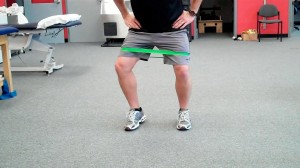Barefoot Rehab
When I posted some rehab ideas for the pain free phase of rehabbing
from plantar fasciitis I felt I didn’t really mention any other ideas to help
retrain your foot musculature besides sand running.
I would advise that the sand running should be a progression
in itself. These exercises I will prescribe now can be seen as a way to safely
retrain the active stabilisers of your foot to work in a more positive,
functional way.
As I touched upon over the past few days barefoot training
seems to have a slight buzz about it currently in the fitness media, Adidas met
this buzz in November 2011 by releasing the Adipure trainer http://www.shopadidas.com/product/mens-training-adipure-trainer-shoes/TD035
. Without knowing too much regarding its success I would love to try this
trainer as it claims to provide you with the shock absorbance needed to avoid
constant bruising from training yet it should allow your foot to work in its
intended way. This is something that a traditional running shoe does not.
I heard a great analogy yesterday regarding dropped arches. Relate
the foot anatomy to a stone bridge. The most crucial stone of the bridge is at
the top. Knock that stone up from the bottom and the bridge would surely
collapse downward.
Look in your running shoe. The likelihood is, is that the
sole of your trainer will rise up in the middle to meet the arch of your foot. Therefore
when you are pounding the pavement, with 7x your body weight, that sole begins
to act as that hammer- potentially resulting in the collapsed bridge.
Training barefoot, or with a minimalist shoe allows your
arches to work the way they were intended. Acting like an elastic band, perhaps
barefoot could put the extra spring back in your step.
I need to credit these exercises and the analogy to Mark
Verstegen, founder and owner of athlete’s performance. http://www.youtube.com/user/athletesperformance
This first exercise will really get your ankle and foot
musculature working hard to maintain a stable posture over your front leg. Hold
the position shown for 5 seconds, slowly returning to single leg standing
upright. Repeat the process 6-8 times.
Secondly. This exercise will not only help your ankle stabilisers
but will get your gluteus medius muscle active. By strengthening this it allows your femur to have a stronger- less internally rotated position which further
down the chain effects your tibial alignment and therefore will help to avoid
an over pronated foot posture.
Hold a squat with the Theraband under tension. Move one knee
out to the side in a controlled manner. Slowly take it back in feeling the
resistance of the band- perform 8 reps on each side.
This 3rd exercise takes it to the next level and adds an
element of Plyometric training to the glute med strengthening whilst taxing
your ankle stabilisers further. Therefore you need to be wary when performing
bare foot as there is an impact element, perform on a floor with some give if
possible. This is where the minimalist shoes come into their own.
Hold the same position as above, perform a side bound, try
to stabilise as soon as possible, then perform a bound in the opposite
direction. 8 on each side- these exercises can then be progressed when
appropriate to sharper cutting movements, perhaps through cones or with another
stimulus (potentially sport related-passing a rugby ball whilst performing
bounds).
Single dumbbell lunges. Hold a dumbbell on the opposite hand
to your lunging leg (ignore image). Lunge forward to gain a 90 degree angle at the knee. Hold
for 3 seconds. Push up tall. Having the dumbbell on the one side forces you to
address the unbalance with your lateral stabilisers of the lunging leg.
Furthermore Mark Verstegen made a good point that the rear leg is also
performing a lot of stabilising work through the big toe. Which is vital for the
final push off phase of a running gait, perform these 8-10 on each leg.
These can be progressed to a more dynamic exercise without
the dumbbell, such as jumping lunges and then to split jump lunges
Finally adopt a semi squat position. Perform a fast sprinting
motion on the spot for 20 seconds x 4 sets. This exercise aims to work on the
speed of your feet. It requires a quick release of energy which aims to produce
a strong ground reaction force- this will result in stronger elastic recoil of
your muscles. So focus on the pushing down more than the pull up. Consequently my
dissertation is looking into the effects of massage on the time it takes the the musculature to reach a peak force output, I highly doubt it will throw up any
groundbreaking evidence but I will post any interesting results with relation
to this.
To progress, perform the same motion but perform with
movement.
If you want to continue to work on Glute Med, as over pronation is
an issue you can also perform this exercise with the Theraband around your
thighs under tension.
Finally, although I have put rough numbers down for
repetition numbers these are simply ball park figures. I want you to work to
fatigue, so if you get to 8 and you think you have a few reps left- do it.
As long
as your pain free, push yourself.
Adam Rutter





No comments:
Post a Comment